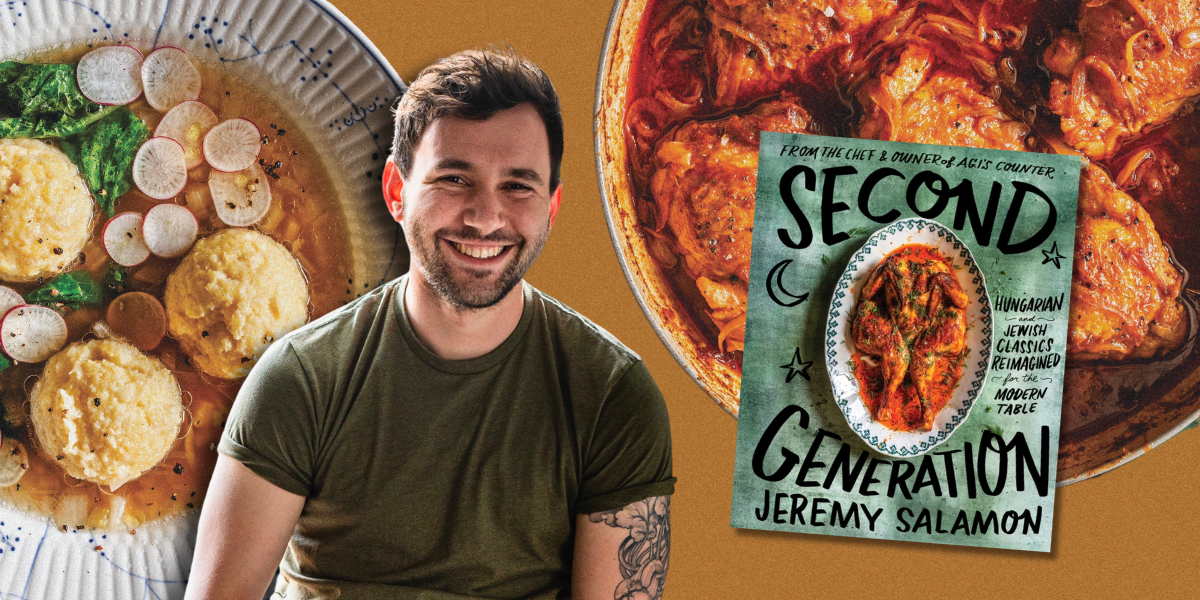Food
Jeremy Salamon’s Hungarian Mashups

Growing up in Florida, Jeremy Salamon was never far from a good meal or great conversation thanks to his two Jewish grandmothers, Agi Salamon and Arlene Ackerman.
“Both of my grandmothers are ladies who lunch, ladies who entertain and ladies who fill up a freezer,” he writes in the introduction to Second Generation: Hungarian and Jewish Classics Reimagined for the Modern Table, his mashup cookbook released in September.
Living in Boca Raton near his grandmothers meant that Salamon spent Friday nights at Grandma Agi’s or Nana Arlene’s with their extended circles of family and friends. Though Nana Arlene’s roots are Sephardi, she more often would serve traditional Ashkenazi dishes like brisket and chopped liver, and Grandma Agi clung to Hungarian classics, including chicken paprikash, goulash and dumplings known as nokedli.
“We would sit around, the grandmas would share gossip, and to me that was the Jewish experience—a room with family, eating and talking for hours and hours,” Salamon, 30, said in an interview from his home in Brooklyn, where he had a rare day off from Agi’s Counter, the Hungarian-inspired restaurant he owns and operates in the same New York City borough.
So formative was his grandmothers’ influence that without their maneuvering, Salamon’s parents never would have met. Arlene and Howie Ackerman, Salamon’s maternal grandparents, ran a family pharmacy in a strip mall in Florida. Nana Arlene befriended Grandma Agi, who, along with her husband, Salamon’s grandfather Papa Steve, ran the dry cleaners next door. The two women set up Salamon’s parents, who are now divorced.
“I probably knew they were Holocaust survivors before I knew they were Jewish,” Salamon said about Grandma Agi, who survived the war in the Budapest ghetto, and Papa Steve, a Czech Holocaust survivor. “Though Agi didn’t talk much about her childhood enduring the horrors of war, Papa Steve did. He wanted us to know about it.”
Grandma Agi’s story remained a mystery to Salamon until he began exploring his roots in his teens, inspired by his growing interest in all things cooking. He started asking questions, and many of his grandmother’s answers—about being forced into the ghetto as a child, and in 1956, escaping to Austria during the violent 12-day Hungarian revolution—came out over plates of fresh palascinta, Hungarian crepes that she would make and top with everything from farmer’s cheese and apricot jam to raspberries and hot fudge.
Salamon’s curiosity about the culinary industry led him to work in restaurant kitchens at an early age. His first job, at a local country club at age 12, involved scooping ice cream into hundreds of goblets for banquets. Eventually, he worked his way up to line cook before departing for the Culinary Institute of America in New York.
After graduation, he worked at well-known New York City restaurants, including Locanda Verde and Prune, before becoming executive chef at The Eddy at age 24. A brief, unfulfilling foray to Los Angeles in 2020 drove him back to New York City, where he became increasingly convinced that there was room for a modern Hungarian-influenced restaurant.
“When people think about Hungarian food, they’re right, it can sometimes be heavy and brown,” Salomon said. “But there is a whole other side to it that is colorful and driven by nostalgia and history.”
He opened Agi’s Counter in Brooklyn in 2021. There, Nana Arlene’s chopped liver and Grandma Agi’s palascinta feature frequently on the menu alongside modern interpretations of nokedli dumplings, now slathered in Italian cacio e pepe sauce or made from semolina and added to warming bowls of brothy radish soup.
Praise followed, with The New Yorker lauding Salamon’s “impeccable pastries and exceptionally thoughtful dishes.” Bon Appetit added Agi’s Counter to its Best New Restaurants list in 2022 and this year, Salamon was nominated for a prestigious James Beard Award.
Though busier than ever—Salamon will soon open a second restaurant, Pitt’s, also in Brooklyn—the dutiful grandson finds time to visit his grandmothers (his grandfathers have passed away). Grandma Agi still resides in Florida and is sadly living with dementia. Nana Arlene moved to Georgia to be closer to family.
“Both of these women and their food helped me get closer to my history,” Salamon said, “and understand my own story.”
Radish Soup & Semolina Dumplings

FOR THE DUMPLINGS
- 1 cup semolina flour
- 2 tablespoons unsalted butter
- 1 large egg
- 2 teaspoons kosher salt
- 1 quart vegetable stock
FOR THE SOUP
- 1 tablespoon canola oil
- 5 celery stalks, finely diced
- 1 medium yellow onion, finely diced
- Kosher salt
- 12 radishes, leaves and radish separated
TO PLATE
- Flaky sea salt and freshly ground pepper
- Extra-virgin olive oil
MAKE THE DUMPLINGS
Bring 2 cups water to a boil in a small saucepan over medium heat. Slowly whisk in the semolina flour. It should become thick very quickly. Continue to cook for 2 minutes and use a wooden spoon to stir constantly. Remove from the heat and whisk in the butter, egg and salt until fully incorporated. Once the semolina mixture is cool enough to handle, use a 3-tablespoon cookie scoop to scoop dumplings. Don’t worry about rolling them smooth; the jagged texture is ideal. Set on a rimmed baking sheet and continue scooping until you’ve used up all the dough, about 16 dumplings.
Meanwhile, bring the stock to a simmer in a medium saucepan over medium-low heat. Working in two batches, carefully lower the dumplings into the stock and let simmer for about 6 minutes, until they float to the surface. Use a wide slotted spoon or spider strainer to divide the dumplings among shallow bowls. Save the stock for the next step.
MAKE THE SOUP
Heat the canola oil in a medium skillet over medium heat. When the oil shimmers, add the celery, onion and a big pinch of kosher salt. Cook, stirring occasionally, until the veggies are translucent but not taking on any color, about 5 minutes. Scrape the veggies into the stock and bring to a boil over medium heat. Meanwhile, use a mandoline or sharp knife to thinly slice the radishes into small rounds. Add the radish greens to the soup and stir until they just start to wilt. Stir the radish rounds into the soup.
TO PLATE
Remove the pot from the heat and ladle the soup over the dumplings. Garnish with flaky salt and plenty of pepper, followed by a drizzle of olive oil.
Good Ol’-Fashioned Chicken Paprikash

INGREDIENTS
- 3 to 4 pounds bone-in, skin-on chicken thighs
- 1 tablespoon kosher salt
- 1/4 cup canola oil
- 2 medium yellow onions, halved and thinly sliced
- 1 tablespoon tomato paste
- 1 tablespoon smoked paprika
- 1 tablespoon hot paprika
- 2 cups chicken stock
- 1/2 cup dairy-free sour cream
INSTRUCTIONS
1. Spread out the thighs on a large plate or tray and pat dry with paper towels. Season on both sides with 1 tablespoon salt.
2. Heat the canola oil in a large skillet over medium heat. When the oil shimmers, add the chicken and cook for 4 minutes on each side until golden brown. You’re not looking to fully cook the chicken here, just getting some color on it. Transfer the chicken back to the plate.
3. Add the onions to the skillet and cook for 10 to 15 minutes, stirring frequently, until soft and starting to caramelize. Add the tomato paste and stir until the onions are fully coated and the paste begins to stick to the skillet, about 2 minutes. Stir in both paprikas and toast for 5 seconds, until very fragrant. Immediately pour in the stock and stir to scrape up any browned bits on the bottom of the pot. Nestle the chicken back in the skillet. Bring the liquid to a boil, then reduce to a low simmer. Cook for 30 to 45 minutes, until the chicken is tender and cooked through. Remove from the heat. Taste for seasoning and adjust if needed.
4. Vigorously whisk the sour cream in a small bowl until it’s light and airy. Dollop over the chicken or serve on the side. Serve the chicken paprikash directly from the skillet
Adeena Sussman lives in Tel Aviv. She is the author of Shabbat: Recipes and Rituals from My Kitchen to Yours and Sababa: Fresh, Sunny Flavors from My Israeli Kitchen. Sign up for her newsletter at adeenasussman.substack.com.










 Facebook
Facebook Instagram
Instagram Twitter
Twitter
Eleanor Kamataris says
Delicious radish soup recipe!
I will prepare chicken recipe for Shabbat!
Thank you for your great taste!